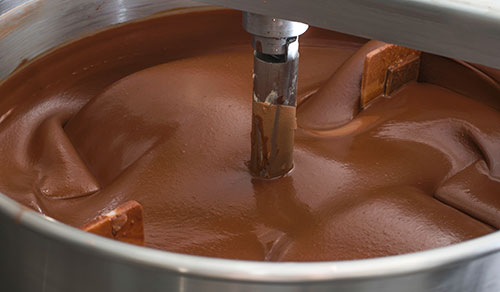
By Michael Banks, Tushna Commissariat and Matin Durrani
Chocolate, the food of the gods, is more popular now as a sweet treat than ever before. And while more and more people know their 70% cocoa from their truffles, “lecithin” still isn’t a word that pops up often. It is an ingredient that plays a key role in chocolate-making and other foods. But this fatty substance has long confounded food-scientists and confectioners alike – we don’t know how this ingredient works on a molecular level and confectioners have had to rely on observations and trial-and-error methods to perfect recipes.
Now, though, chocolatiers have had help from an unexpected field – that of molecular biology – to figure out chocolate “conching” – the part of the chocolate-making process where aromatic sensation, texture and “mouthfeel” are developed. In a special issue on “The Physics of Food” published in the Journal of Physics D: Applied Physics, Heiko Briesen and colleagues at Technische Universität München, Germany, use molecular dynamics to model and simulate how lecithin molecules, made from different sources, attach to the sugar surface in cocoa butter. “I’m quite confident molecular dynamics will strongly support food science in the future” says Briesen.
When you’re some 400 km from Earth aboard the International Space Station (ISS), the last thing that you want is to run out of is food and water – an issue that would be even more pressing for any future astronauts going on a trip to Mars. NASA is now trying to tackle that problem by awarding a $200,000-a-year grant that will study the possibility of turning human waste back into food. The three-year grant – examining “synthetic biology for recycling human water into food” – was awarded to a group of researchers led by Mark Blenner from Clemson University in South Carolina. The team’s going to be looking into how to use astronauts’ waste as food or if it can be put it to use as a fertilizer.
Something that is already well recycled on the ISS is urine. US astronauts regularly drink their own wee, which apparently ends up tasting just like “bottled water”, according to Layne Carter, water subsystem manager for the ISS at NASA’s Marshall Space Flight Center in Alabama. But as Bloomsberg reported this week, Russian astronauts have refused to do the same. This nyet to urine does have its advantages for the US astronauts, however, as they receive the Russians’ samples for their own consumption. “We collect it in bags, and then the crew hauls it over to the US side,” explains Carter. “We don’t do 100% of the Russian urine. It depends on our time availability.”
Still up in space, you’ll be pleased to hear that The Three Body Problem by Cixin Liu (translated from the original Chinese by Ken Liu) was named “best novel” in this year’s Hugo awards, which claim to be “science fiction’s most prestigious awards”. Published by Tor Books, the novel is about aliens under threat of extinction that make contact with Earth. Winners are selected by a ballot of fans attending the annual World Science Fiction Convention (“Worldcon”).
A bestseller in Liu’s native China, The Three Body Problem was reviewed in the May issue of Physics World by the US-based science writer Jennifer Ouellette, who said it offers “a refreshing take on the well-worn ‘hostile aliens’ trope, creating an intricate, suspenseful and multi-layered novel peppered with memorable characters marked by tragedy”. All of which sounds a bit like this year’s Hugo awards themselves, which were tarred by controversy after three white, male writers – seemingly unhappy with the awards increasingly going to people other than white, male writers – campaigned to get the shortlists dominated by, er, white, male writers. The resulting brouhaha is examined in all its gory detail by blogger Amy Wallace over at Wired.
Finally, if you thought physicists weren’t known for their good dress sense, think again. BuzzFeed – those masters of click-bait – have drawn up a collection of “11 pictures that prove physicists were the original hipsters”. Hipsters are – so says Urban Dictionary – a group of people who often wear “vintage and thrift store inspired fashions, tight-fitting jeans, old-school sneakers, and sometimes thick-rimmed glasses”. We’ll let you judge for yourself if the 11 on the list – including Albert Einstein, Rosalind Franklin, Robert Oppenheimer and Marie Curie – fit that bill.



